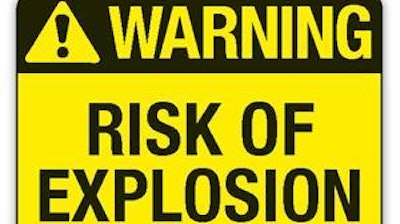
The combustive power of airborne particles, such as dust, is astounding and can be a threat to a number of different industries. In response, Goodway Technologies recently created a list of leading strategies for preventing dust explosions.
- Most dusts are combustible. According to the Occupational Safety and Health Administration (OSHA), any solid that can catch fire can become explosive when turned into dust.
- Provide access to all hidden areas of a plant or facility. Make sure that every horizontal surface in a plant can be accessed, including ductwork, beam and joist surfaces, and the area above suspended ceilings in order to assess dust buildup.
- Regularly inspect for dust. OSHA inspectors look for accumulations of 1/32", which is about the thickness of a standard paper clip. Immediate cleaning is necessary when a layer of that amount covers a surface area equal to five percent of the floor area.
- Clean at regular intervals. Put a plan in place to conduct timely cleaning. Work cycle dust should be removed concurrently with operations and not be allowed to accumulate. Be mindful of dust dispersion during housekeeping.
- Move dust collectors outside. Dust collectors with a volume of greater that 8 cubic feet should be located on the exterior of a building to limit risks.
- Ensure electrical wiring and equipment is approved for dust hazard conditions. OSHA also recommends, “The use of proper electrical equipment in hazardous locations is crucial to eliminating a common ignition source.”
- Only use certified industrial vacuums for explosive material pickup. Essential in hazardous dust environments, “explosion-proof vacuums” approved for Class II conditions don't produce sparks.
- Control ignition sources. Post "No Smoking" signs. Control static electricity by bonding and grounding equipment. Provide personal protective equipment, as needed, not only as a protective barrier for the employees, but also to prevent the ignition from static electricity.
- Perform regular preventative maintenance on equipment. Equipment in bad repair is a common cause of ignition.
- Train employees to recognize and prevent hazards. Proactively train new employees before they start work and again periodically, to refresh material, or when they are reassigned. In addition to understanding safe work practices relating to their tasks, employees should also know the overall plant programs for dust control and ignition source control. Develop a company culture of safety by encouraging employees to report unsafe practices.
If fine dust, powders, or other flammables are used in the facility, think about using these tips and to start your preparedness. A hazardous location is defined by the National Electrical Code (NEC) as a working area with a risk of explosion or fire due to the presence of flammable gases, vapors, dust, or ignitable fibers in the air.
Electrical sparks, arcs, or hot surfaces may cause gases and other airborne particles to ignite, resulting in injury, loss of life, and property damage.






















